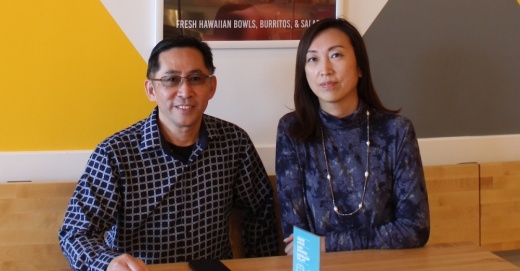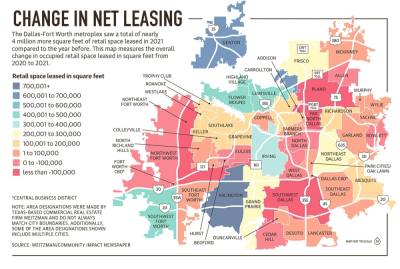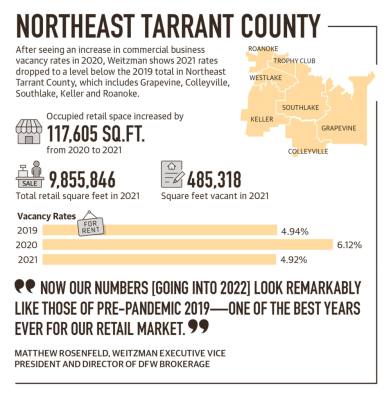While renovating a strip building they own in Southlake, they ran into labor and material shortages during construction, Lo said. Finding restaurant staff was also a challenge, he said.
Lo said Pokeworks in Southlake has seen some initial success since opening last August, especially with online ordering and outdoor patio dining, two trends that have helped many businesses across the Dallas-Forth Worth area make it through the past two years.
“We’re in a much better place today [than March 2020],” said Michelle Caplan, executive vice president of the Texas-based commercial real estate firm Weitzman.
“Everyone from retailers to landlords to shoppers... have all faced enormous challenges with innovation and ingenuity. We’ve navigated risk and achieved one of the greatest market turnarounds ever.”
Lo said that one thing that has helped keep Pokeworks going strong is its online ordering system.
“Right now, about one-third of our sales are takeout,” Lo said. “That is getting closer and closer to half.”
Having a place where people could dine safely was also a priority, Lo said.
“When I built the restaurant, I knew I wanted a patio outside so that people could stay and eat here for a bit like they did before,” Lo said. “Everyone is kind of ready to get back to their normal lives.”
That return to in-person shopping and dining is something Weitzman said is happening throughout the Dallas-Fort Worth metroplex.
“People don’t want to sit at home and buy everything,” said Noam Ben-Zvi CEO and co-founder of location data analytics firm Placer.ai.
The company tracks consumer foot traffic for retail and real estate companies using mobile device data. Ben-Zvi said at the January event that he believes shopping centers are “here to stay.”
As part of its report, Weitzman noted construction of new retail space in the region was at an all-time low in 2021, with just 640,000 square feet of new space added. That was nearly half the previous record low of 1.2 million square feet built in 2012, according to Matthew Rosenfeld, Weitzman executive vice president and director of brokerage for DFW. However, increased demand for retail space and rising occupancy rates are expected to help turn things around in 2022, according to the forecast.
“We expect construction to total approximately 2 million square feet [in 2022],” Caplan said.
The Weitzman forecast also found retail occupancy was at 93.5% throughout the region at the end of 2021. That rate was the third-highest total the firm has recorded for DFW, just below its previously recorded highs of nearly 94% in 2019 and almost 95% in 1981.
The firm’s data is based on more than 200 million square feet of retail space across the metroplex. Weitzman’s forecast for this year expects retail occupancy to increase to 95%.
The retail leasing market in 2021 was also the third strongest the firm has seen in 22 years, according to Rosenfeld.
“This is [a] complete reversal from 2020, when pandemic-related closures resulted in vacancy jumping by more than 4 million square feet,” Rosenfeld said at the January forecast. “Now our numbers [going into 2022] look remarkably like those of pre-pandemic 2019—one of the best years ever for our retail market.”
Adapting in Grapevine and Colleyville
While restaurants and smaller businesses suffered at the height of the pandemic, Chelsea Rose, the Colleyville Chamber of Commerce president, said financial advisers did lunch-and-learn events through the chamber to help.
“[Advisors] were able to educate during that time of uncertainty,” Rose said. ”There were a lot of really creative things that [businesses] were able to discover.”
Of those adaptations, Rose said she noticed curbside pickup at both restaurants and retail shops became prevalent—and stayed prevalent.
“I feel like ‘curbside’ became much more of a buzzword than it ever was before,” Rose said. “Before you’d see maybe a [parking] space or two designated to that, but you quickly saw so many of those. Now, they’re still everywhere.”
That change is also happening with restaurants, such as Velvet Taco, Caplan said. That eatery and others are modifying some of their existing restaurants to include digital drive-thru windows that allow customers to pick up online orders with minimal contact, she said.
Velvet Taco has announced plans on its website to open a new restaurant at 440 W. Hwy. 114 in Grapevine.
A shift in work environments in recent years is also being incorporated into the design of new apartments and townhomes, according to Matt Enzler, a senior managing director with multifamily development company Trammell Crow Residential. The company has built multifamily developments throughout the metroplex.
“We’re adding more home office-type options, whether it’s a full dedicated study or if it’s just adding a spot ... for a [personal] workspace,” Enzler said. “Then outside the unit we’ve added, for all of our new developments, ... more workspace. You don’t necessarily want to live and work in the same spot 24 hours a day.”
While Trammell Crow was incorporating many of these options into designs even before the pandemic began, Enzler said the company has put more of an emphasis on these features, and he expects that will continue.
“I don’t think there’s any question people will have a more flexible work schedule and more work from home [opportunities] ... so we need to be able to provide [work spaces] for them,” he said. Businesses on Main Street in Grapevine also had to learn how to adapt quickly, said Garin Giacomarro, the city’s assistant director of economic development. Giacomarro said many Grapevine businesses reported March 2021 was the best spring season their business had ever had.
“There’s a lot of pent-up demand and a lot of customer support. So, we’re feeling pretty good.” Giacomarro said.
‘Tech and mortar’
Weitzman’s Rosenfeld said grocery stores throughout the region have led the way in using digital tools to help physical retailers meet changing customer needs. That is an approach Weitzman refers to as “tech and mortar.”
“Without a doubt, COVID[-19] has transformed grocery shoppers’ behavior, and brick-and-mortar locations [that] are offering delivery and curbside pickup [are] benefiting,” Rosenfeld said.
Many Grapevine businesses benefited from this tech and mortar approach, Giacomarro said.
“[We] saw a lot of determination ... a lot of creativity about how they were kind of addressing things. There were a lot of retailers who never would have considered [doing] online orders and had to sit down and figure out how to make that happen,” Giacmarro said. “I think most of them benefited in the end of it, but they were kind of pushed into that.”
The future of business looks bright as interest in Texas, the Dallas-Fort Worth area and Grapevine stays consistent, Giacomarro said.
“We are super competitive, especially coming out of what’s happening now that we’ve recovered very quickly,” Giacomarro said. “So there is just a lot of optimism.”









